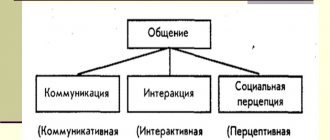Greetings, friends!
For most people, speech is the main means of everyday communication. At the same time, each of us knows very well that understanding a person when talking to him on the phone is sometimes more difficult than during a normal conversation. The reason is the lack of non-verbal interaction, because gestures and facial expressions are very important for understanding, but during a telephone conversation we do not see them. Today we will look in detail at what nonverbal communication is, what forms it takes, what meaning it has, and how to learn how to use it as effectively as possible.
Means of nonverbal communication
The main means of such communication is the body, which is capable of transmitting information through facial expressions, gestures, pantomime, changing position in space and the mise-en-scène of communication.
Due to the diversity and richness of facial capabilities, our body is capable of transmitting a huge number of images, becoming a powerful tool for conveying the necessary information to people around us.
It’s very easy to check this: just try to watch a movie in a foreign language that you don’t speak, and you will be surprised to note that you understand, if not the very essence of the characters’ conversations, then the message, the emotions that they put into the conversation, and even main idea and plot.
This is due to the fact that, in conditions of semantic deficit arising from ignorance of the language, we subconsciously monitor facial expressions, micro-gestures more closely than usual, and read the plot and emotional components from the movements and tone of voice of the characters.
Eye contact
This method of body language allows you to demonstrate interest in the conversation and better understand the meaning of what is being said. During the conversation, both people create and then adjust their comfort level. To do this, they periodically meet each other's gaze. Then they take them aside. Staring can both build trust and create feelings of discomfort.
Eye contact maintains common themes that are pleasant to the interlocutors. Confused and negative questions lead to a person looking away, thereby demonstrating his hostility and disagreement. Those features that are characteristic of a particular eye contact allow us to draw reliable conclusions about the level of interest in the conversation and attitude towards the speaker. So, with:
- indignant, the gaze becomes intent, intrusive and a little alarming
- in admiration, eye contact is prolonged and the gaze is calm;
- the position towards the interlocutor is attentive, and eye contact is interrupted every 10 seconds;
- in anticipation, the eyebrows are raised and the gaze is sharp;
- hostility, a person rolls his eyes and avoids eye contact.
Language
Saying that we speak one language, for example, Russian, we little think about the fact that we actually know two languages: not only language as a means of verbal communication, but also body language - a universal complex of postures and movements with the help of which Representatives of different nationalities, cultures and races can communicate.
Unlike dictionary language, to master which you need to study the alphabet, phonetics, grammar and other components, sign language is unique: using obvious mental images and concepts, we can establish communication with both Amazonian Indians and Eskimos.
Of course, this communication will be simple, at the level of basic concepts, but without the use of means of non-verbal communication, through the use of words alone, we will not achieve anything at all - our language will be incomprehensible to our interlocutors, while pointing a finger at a subject of interest is universal and will help establish initial contact .
Nonverbal signals as the only means of communication
The importance of non-verbal communication cannot be overestimated - it remains the only means of exchanging information in cases where:
- people do not know each other's language even at a basic level;
- people do not have the physical ability to make sounds.
If in the first case it is subsequently possible to establish a higher level of communication through the gradual study of each other’s languages, then in the second, various types of non-verbal communication come to the fore and become the only possible means of contact.
For people with speech disabilities and hearing loss, sign language is the only language they can use, and their fingers become their vocal cords and their gestures become their words.
In situations where people who are physically capable of producing sounds find themselves in an environment that does not allow them to pronounce these sounds, it is the tools of nonverbal communication that come to the fore. These signals are used in scuba diving (dive signals), in noisy rooms (rolling shops, engine rooms), while hunting, and when participating in hostilities (ambushes).
The history of the emergence of nonverbal means of communication
Nonverbal behavior as a set of gestural and figurative expressions through the body arose at the dawn of humanity, when language as a means of communication had not yet been invented, and communication between individual representatives of the tribe was carried out precisely through nonverbal behavior.
It was possible to convey information through primitive gestures, and non-verbal means of communication coped with the task that ancient people needed to solve perfectly. They pointed to prey and fellow tribesmen with their hands, depicted simple phenomena - rain, thunderstorms, mimicked anger, threatened, grinning and baring their teeth.
An excellent example of primitive nonverbal behavior is the communication of dogs. Dogs almost never bark when meeting - they communicate by changing their gait, posture, level of tail movement, grinning or lowering their ears, and the information they receive is enough for them to correctly assess the situation and the status of their interlocutor.
Conscious and unconscious use of body signals
Nonverbal means of communication can be divided into two types based on the consciousness of use:
- nonverbal communication that we use consciously is those facial and gestural means that we use deliberately, that is, the tools we use to clearly convey specific information to the addressee;
- involuntary nonverbal behavior is those postures, gestures and changes in body position, as well as microgestures that we use unconsciously, uncontrollably. A specialist who knows how to read the signs of involuntary nonverbal behavior can tell more than the words we say.
Consciously used such means of communication provide a large layer of gestural, plastic and facial capabilities. Actors most clearly demonstrate this type of non-verbal communication tools: when playing a role, they use gestures and facial expressions to bring the image to perfection and give credibility to the game. The tools of good actors are very rich; they are able to remember and apply hundreds of different small poses, glances, turns of the head, which add variability to the words they use for the role.
Microexpressions and involuntary nonverbal cues
Involuntary nonverbal behavior is those contractions of the muscles of the body and face that a person is unable to control.
Consciously telling a lie, trying to hide feelings, a person is nevertheless unable to control the so-called micro-expressions flashing on the face. These are tools of non-verbal behavior that help a specialist psychologist or simply a very observant interlocutor to recognize deception, an attempt to hide information or emotions, since it is impossible to consciously keep muscles from contracting such muscles.
Representatives of certain professions, for which the ability to recognize deception is very important, are taught this ability, or they look for people who are initially predisposed to reading microexpressions. Thus, the ability to detect a lie is extremely important for customs officials, security services, and investigators.
To correctly recognize facial microexpressions, it is important to remember that facial expressions do not express the subject’s thoughts, but feelings, and if disgust flashes on the face for a moment, this does not mean that it is caused by the subject of the conversation - perhaps the person simply has an unpleasant association.
Consciously reading nonverbal cues
Like the use of nonverbal behavior, the ability to correctly read and recognize nonverbal signals given by an interlocutor can be conscious and unconscious.
Conscious reading of nonverbal behavior allows us, by observing the interlocutor, to understand by his facial expression, posture, gait, and even the turn of his shoulders, what feelings he is experiencing and what shade his speech has.
For example, the phrase: “I hate you!” written on paper cannot be read unambiguously without a description of the facial expressions of the speaker. In life, the nonverbal behavior of the speaker will say a lot about the subtext:
- if it is pronounced expressively, with frowning eyebrows, pursed lips and lowered corners, with tense fists, the interlocutor will understand the message - he is really hated, since the whole posture and face of the speaker expresses anger;
- pronounced in a cheerful tone, supported by a smile and a casual wave of the hand with a relaxed body, the same phrase becomes a playful, friendly joke.
It is at such moments that non-verbal means of communication are indispensable; it is not for nothing that authors of fiction often use the epithets “muttered”, “shouted out”, “hissed” instead of the dry “said”, giving faceless words an obvious emotional connotation.
Facial expressions
Our facial expression is the main element that reflects a person’s feelings and emotions. This is facial expressions.
We recognize any positive emotions much more easily than negative ones. Love and surprise are not as hidden by a person as anger or disgust. Researchers have proven that emotions are reflected differently on the left and right sides of the face. This is explained by the different functions assigned to the hemispheres of the brain. So, the right is responsible for the emotional sphere, and the left is responsible for intellectual functions.
In facial expressions, emotions are expressed as follows:
- a state of anger is accompanied by wide open eyes, clenched teeth, and downturned corners of the lips;
- surprise can be judged by the slightly open mouth, raised eyebrows and wide open eyes;
- when fearful, a person brings his eyebrows together and stretches his lips, lowering and pulling down their corners;
- happiness corresponds to a calm gaze, as well as drawn back, raised corners of the lips;
- a sad person can be recognized by his dull gaze, knitted eyebrows and downturned corners of his lips.
Unconscious reading of nonverbal cues
Just as the body gives away our lies by broadcasting involuntary nonverbal signals in the form of momentary microexpressions and gestures, our subconscious mind is able to read these types of nonverbal communication.
For example, you are communicating with an interlocutor who seems to be saying something pleasant, positive, making promises and convincing of his loyalty, but something inside you is itching: “He is lying, fawning, trying to hide information, he cannot be trusted!” . Some call it intuition, others call it a premonition, but from the point of view of the science of nonverbal communication, this is nothing more than the unconscious reading of the microexpressions of the interlocutor, comparing them with words and subconsciously assessing the correspondence. When a discrepancy is found between verbal and nonverbal signals, the brain tries to tell you in every available way: the person is hiding something, the gestures do not correspond to the words, you need to be on your guard!
Unconscious nonverbal behavior cannot be controlled, and specialists who can read such microexpressions learn to turn unconscious recognition of nonverbal communication gestures into conscious awareness through extensive training.
Recognize deception
Is it possible to feel comfortable and confident when communicating with different people? Yes, but this requires knowledge of non-verbal communication. This will allow you to avoid situations where the interlocutor is trying to deceive.
The correspondence between the verbal and nonverbal signals given is called congruence. In this case, we can say that the interlocutor is telling the truth. They will tell you about the falsity of the information provided:
- too frequent or long pauses, as well as hesitation before each remark;
- lack of synchronicity in the work of facial muscles, asymmetry of facial expressions;
- a frozen expression on the face that remains unchanged for 5-10 seconds;
- the occurrence of pauses between the word and the emotions related to it;
- a forced smile;
- shallow eye contact, with a restless facial expression;
- twitching of any part of the body, biting lips, tapping on the table with fingers;
- few gestures under the control of the liar;
- heavy breathing and high pitched voice;
- crossed legs and bent body;
- blinking eyes at a high frequency.
Basic characteristics of nonverbal signals
Various parts of the body are used as tools to use and read such signals, but posture, gait, and plasticity are also important.
The nonverbal behavior of an open, self-confident subject is characterized by the following features:
- straight back, shoulders turned, good posture, free gait;
- raised head, confident look directly at the interlocutor;
- “open” gestures - relaxed arms, not closed on the chest or in a “lock”, legs not crossed;
- absence of fussy small gestures, attempts to cover your mouth or nose with your palm.
Nonverbal means of communication that demonstrate that a person is trying to hide something:
- drooping chin, tense shoulders, slight hunching;
- a gaze constantly moving from the interlocutor’s face to the floor or running over objects behind his back;
- “closed” gestures - arms crossed on the chest, a “leg to leg” pose, involuntary touching of the nose and lips with fingers, hands “housed” at chin level.
Such signs of nonverbal communication allow you to assess the degree of frankness of the interlocutor, help you take a sober approach to what he says, and decide whether to trust the person.
Interpersonal space
The distance at which the interlocutors are from each other plays an important role in establishing contact. Often people express their feelings using categories such as “I want to be closer” or “stay away from him.” People interested in each other reduce the space separating them. It could be:
- intimate - up to 0.5 m, expressing a trusting relationship between friends and loved ones;
- interpersonal (from 0.5 to 1.2 m), which is comfortable during a friendly conversation;
- social (from 1.2 to 3.7 m), characteristic of informal interaction during a business meeting;
- public - over 3.7 m - this is the distance for a person speaking in front of a group of people.
The significance and scope of such distances are directly dependent on a person’s gender and age, as well as on personal characteristics. Thus, children are always more comfortable being closer to their interlocutor, while teenagers more often close themselves off and try to distance themselves from those with whom they are conducting a dialogue. Women prefer closer distances, but self-confident and balanced people do not care about it.
Business conversation
Nonverbal means of communication in negotiations and at work are of great importance: despite the formal unspoken ban on an overly expressed emotional component in business communication, a successful salesperson is able to either fail a product presentation or save it with the help of properly constructed nonverbal communication with listeners.
If a specialist presenting a product or technology presents it, monotonously reciting the text, without using a change in intonation, without supplementing the words with gestures, facial expressions, if he slouches and nervously rubs his hands, the listeners unconsciously read all these signs of uncertainty and are imbued with distrust of the product through distrust of the person presenting it to a person.
If the presentation is accompanied by competently delivered speech, rich in intonation, supported by open gestures, a smile, good posture and an open look, unconscious non-verbal communication signals: your interlocutor is worthy of trust, which means the product is too.
Nonverbal cues in face-to-face communication
Nonverbal communication in personal relationships is the basis of communication. Words alone, without emotional reinforcement, without touches and small, but unconsciously read signals, will not get you far in family life.
Spouses may communicate little, exhausted by everyday life, children and work, but if in a dream they move closer to each other, if in rare hours of being together in the house, even when each is busy with his own business, they find a second to touch each other, smile - such the family is strong.
On the contrary, couples who publicly hug, kiss and otherwise express positive emotions at the level of conscious non-verbal signals, but do not experience warm feelings for each other, betray themselves by the absence of small gestures - momentary touches, glances, light smiles, and others often unconsciously read this information and before the spouses themselves begin to guess that something is wrong in the family.
To maintain relationships, it is very important to remember about non-verbal means of communication, not to underestimate the importance of touch and expressing emotions not only through words.
What is sympathy
Sympathy is fascination and an emotionally positive attitude towards a person. It can manifest itself in the form of attention, desire to communicate and recognize the identity of another. Touch also plays an important role, because if you like a person, then you want to touch him all the time, touch him carefully, remove invisible specks of dust, hug him.
Tactile sensations are extremely important in any relationship. They help to quickly establish trusting relationships, because the first feelings a person experiences are the mother’s touch. They give a feeling of security, trust and safety.
Unconscious touches, for example, to one’s own hair or clothes, can also reveal sympathy. The desire to look perfect can indicate interest in another person, a desire to please him.
How to learn to correctly recognize nonverbal signals
By learning to correctly interpret other people's nonverbal signals, you can expand your capabilities, raise nonverbal communication with your interlocutors to a new level, and also learn to recognize attempts to manipulate you.
In order to improve non-verbal communication skills, try to absorb when communicating, notice not only some noticeable, “large” gestures, but also note small ones, perceive the entire palette of human motor skills: facial expression, posture, posture, finger movements and gaze, shift intonation. This will allow over time to cut off superficial, conscious gestures of the interlocutor, identifying micro-expressions and noting signs of deception or unconscious lies. By noticing the broad gesture of your hands, you will also learn to notice the rapid licking of lips that betrays excitement, and then non-verbal communication with people will turn into an exciting ride in which attempts to manipulate you will be broken by your ability to recognize them and avoid them.
Flying gait
A beautiful gait is another non-verbal signal for men. The stronger sex is attracted by a straight back, laid back shoulders, and cat-like grace. Don't wave your arms too much - it looks awkward.
You can read a person's character by their gait. This applies not only to women, but also to men. A fearful person takes small steps. Soldier's march means a tendency to manipulate and command. Angular movements will tell about the duality in character. Such a person tries to defend himself, but may suddenly show aggression.
It’s bad when your legs move and your arms hang limply along your body. This shows helplessness and unwillingness to take the initiative. In non-verbal language it says: “I am weak, do everything for me.” Men don't like such women.
In the film “Marriage Italian Style,” Sophie demonstrated an amazing gait that became a textbook. Her husband, a director, taught her to walk beautifully. He came up with a very funny way to train. The actress had to walk between two rows of bedside tables and close their doors with her hips. Sophie practiced until the slamming of the doors was barely audible.
Nonverbal communication and errors
Non-verbal communication is an important component of human communication, and the ability to understand signals helps a lot in life, but we should not forget that excessive enthusiasm for the theory of micro-expressions and unconscious gestures can fail if we do not remember the possibility of mistakes. You should always remember the conditions in which the dialogue is being conducted: in a stuffy room with dry air, for example, licking your lips can symbolize not so much an attempt to deceive as to moisturize dry skin, and folded hands on your chest are sometimes intended not to close yourself off from your interlocutor, but to cover up a poorly placed stain on clothes.
Nonverbal communication is a huge layer of information that you need to be able to use in order to improve your communication skills and learn to avoid outside manipulation.
Takeshika
Takeshika studies non-verbal dynamic methods of communication - shaking hands, kissing, patting. Scientists have proven that touch is a biologically necessary form of stimulation for humans. An individual uses different types of touch depending on the status, age, and gender of the partner.
- Handshake - can be equal, dominant (strong, with the hand on top), submissive (weak, with the hand on the bottom).
- Patting on the shoulder is a tactical technique that is used when the interlocutors have a close relationship, as well as when they are socially equal.
- Kiss - used in close communication - relatives and acquaintances (friendly), couples in love (intimate).
Incorrect use of these tactical elements can lead to an inadequate reaction from the opponent and to conflict situations.











